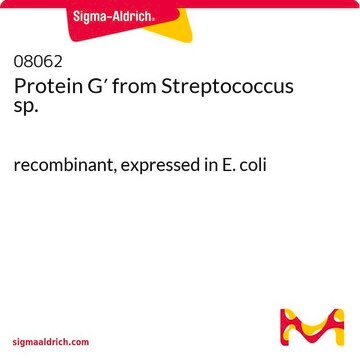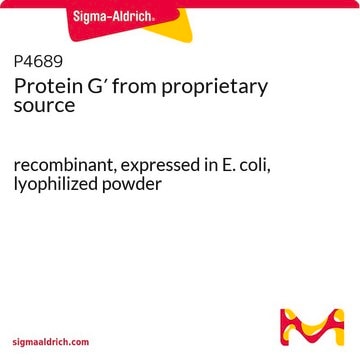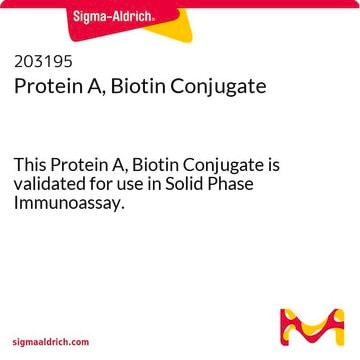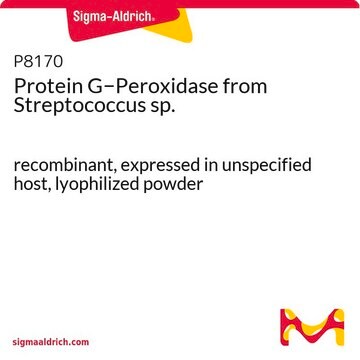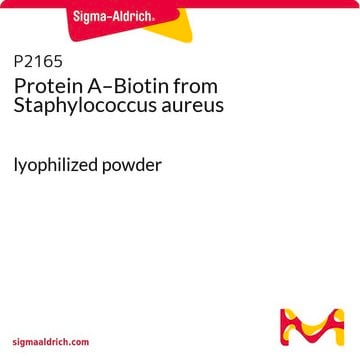P8045
Protein G-Biotin from Streptococcus sp.
recombinant, expressed in unspecified host, lyophilized powder
Synonym(s):
Biotinylated Protein G, Protein G Biotin, Protein G-Biotin
Sign Into View Organizational & Contract Pricing
All Photos(1)
About This Item
Recommended Products
recombinant
expressed in unspecified host
Quality Level
conjugate
biotin conjugate
form
lyophilized powder
composition
Protein, ~90% biuret
extent of labeling
2-4 mol d-biotin per mol protein
technique(s)
direct ELISA: 1:70,000 using human IgG
storage temp.
2-8°C
General description
Protein G binds to antibodies reversibly and thus, it is considered in antibody purification. It is a 20 kDa protein.
Protein G is an immunoglobulin (IgG) specific bacterial cell wall protein isolated from Streptococci (group G). Native proteins G consist of two IgG-binding domains and albumin and cell surface binding sites. Biotin is a water soluble vitamin that acts as a coenzyme for carboxylase enzyme reactions. Biotin deficiency results in deregulation of metabolic pathways and various physiological impairments. Biotin deficiency is known to cause birth anomalies indicating its important role in development and differentiation of embryos.
Specificity
Binds IgG only from most mammalian species except cat; binds chicken IgG.
Application
Protein G-Biotin from Streptococcus sp. has been used during incubation for synergistic immunocapture of antigen which was performed using streptavidin-coated magnetic beads.
Protein G-Biotin from Streptococcus sp. has been used in electrochemical biosensing, for the attachment of antibodies with different specificities.
Packaging
Package size based on protein content
Other Notes
Truncated - lacks albumin, Fab and membrane binding sites.
Preparation Note
Prepared using biotinamidocaproate N-hydroxysuccinimide which incorporates an aminocaproyl spacer.
Disclaimer
Unless otherwise stated in our catalog or other company documentation accompanying the product(s), our products are intended for research use only and are not to be used for any other purpose, which includes but is not limited to, unauthorized commercial uses, in vitro diagnostic uses, ex vivo or in vivo therapeutic uses or any type of consumption or application to humans or animals.
Storage Class Code
11 - Combustible Solids
WGK
WGK 3
Flash Point(F)
Not applicable
Flash Point(C)
Not applicable
Personal Protective Equipment
dust mask type N95 (US), Eyeshields, Gloves
Certificates of Analysis (COA)
Search for Certificates of Analysis (COA) by entering the products Lot/Batch Number. Lot and Batch Numbers can be found on a product’s label following the words ‘Lot’ or ‘Batch’.
Already Own This Product?
Find documentation for the products that you have recently purchased in the Document Library.
Customers Also Viewed
Principles of Bacterial Detection: Biosensors, Recognition Receptors and Microsystems: Biosensors, Recognition Receptors, and Microsystem, 21(7), 360-360 (2008)
Ayumi Taniguchi et al.
Journal of nutritional science and vitaminology, 53(6), 457-463 (2008-01-19)
It is well known that biotin deficiency causes morphological anomalies in hatchlings of fowl. An abundance of biotin in the yolk, therefore, is greatly required for maintaining reproductive functions. Although there is growing evidence for the molecular significance of the
Pierre-Henri Puech et al.
PloS one, 6(7), e22344-e22344 (2011-07-30)
The rupture forces and adhesion frequencies of single recognition complexes between an affinity selected peptide/MHC complex and a TCR at a murine hybridoma surface were measured using Atomic Force Microscopy. When the CD8 coreceptor is absent, the adhesion frequency depends
T Klonisch et al.
Immunology, 89(2), 165-171 (1996-10-01)
The effects of orientating pairs of synergistic monoclonal antibodies (mAb) on binding of human chorionic gonadotropin (hCG) was studied by radioimmunoassay (RIA), enzyme-linked immunosorbent assay (ELISA) and surface plasmon resonance (SPR). Antibody synergy towards hCG required two functionally intact antibodies
Electrochemical biosensing based on universal affinity biocomposite platforms
Zacco E, et al.
Biosensors And Bioelectronics, 21(7), 1291-1301 (2006)
Our team of scientists has experience in all areas of research including Life Science, Material Science, Chemical Synthesis, Chromatography, Analytical and many others.
Contact Technical Service
